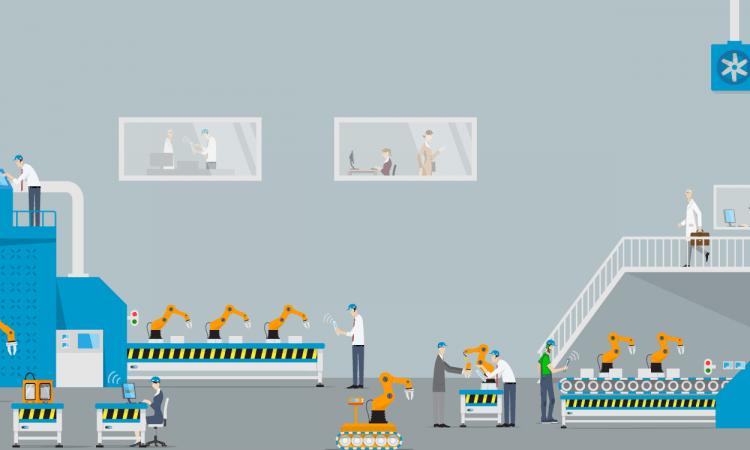This is part 4 of a 5-part series called Turning Data Into Insights. This blog series explores best practices relating to the product lifecycle management approach, and how these best practices will help drive Industry 4.0.
One of the biggest trends relating to product lifecycle management (PLM) and today’s manufacturing climate is how rapidly organizations are accumulating data. The question becomes, once companies have all this data – what now? The goal of any good PLM approach is to present the best and most relevant information to stakeholders – on demand and throughout the product’s lifecycle.
The question becomes, once companies have all this data – what now?
Jim Zwica
Data is unusable without the people to make business-critical decisions. When teams transform massive pools of data into useful, timely, and actionable information, all stakeholders throughout the enterprise can take advantage of the data during the product’s lifecycle. This is the first true step towards smart manufacturing and Industry 4.0. By investigating best practices and how people are leveraging data to make decisions, organizations can implement their own time- and cost-saving activities, decrease time-to-market, and optimize products.
SMART FACTORIES
Smart factories allow for the unprecedented customization of products and greater collaboration, ultimately creating entirely new operating models. A Deloitte Insights article identifies five key characteristics of a smart factory:
- Connected. Process, material, and data integration enables real-time, data-informed decisions.
- Optimized. Data-driven operations minimize manual intervention and maximize reliability.
- Transparent. Real-time metrics and tools create greater visibility across the enterprise.
- Proactive. Predicted and automated activities enables real-time safety monitoring and identifies quality issues
- Agile. Flexible and adaptable changes occur with minimal intervention
According to the article, the smart factory “should not be considered the ‘end state,’ given the rapid pace of development. Rather it represents an ongoing evolution, a continuous journey towards building and maintaining a flexible learning system—rather than ‘one and done’ factory modernization approach of the past.”
When teams transform massive pools of data into useful, timely, and actionable information, all stakeholders throughout the enterprise can take advantage of the data during the product’s lifecycle.
Jim Zwica
Unfortunately, mainstream discussions leave out product design. To truly realize the benefits of Industry 4.0, both manufacturing and product design will need to evolve.
SMART PRODUCTS: ROLLS-ROYCE
Much of the smart factory discussion focuses on real-time product data as a source of intelligence. Wired up to suites of sensors, products transmit their vital signs throughout the lifecycle from manufacture, into service, and up to its disposal.
For example, the Rolls-Royce Engine Health Management (EHM) system tracks engine health for thousands of products. Their modern Trent-series engine contains approximately 25 sensors, which provide real-time feedback and monitoring, 24 hours a day – before, during, and after a flight. The sensors monitor multiple critical engine characteristics such as temperatures, pressures, speeds, flows, and vibrations. This data informs engineers that the engine is functioning normally and generates alerts when it is not.
Data is unusable without the people to make business-critical decisions.
Jim Zwica
Rolls-Royce receives hundreds, sometimes thousands, of engine health reports every day. An automated system analyzes the performance and detects any faults, even before they occur. This allows the engine manufacturer to provide prescribed maintenance advice to aircraft operators which can improve the lifespan of the engine and prevent engine downtime.
Naturally, the data is not only useful for maintaining the current fleet, but also impacts future product development. According to Rolls-Royce:
“Broader engineering disciplines can benefit from the data that is collected. As operational profiles of technical performance are revealed in ever more detail – from individual components to whole engines – so engineers can develop more thorough and cost-effective maintenance schedules and designers can feed higher reliability features into the engine products of the future.”
Given the large number of stakeholders involved in aircraft operations, the EHM emphasizes collaboration with information flowing from the engine to product design and manufacturing at Rolls-Royce and then to the aircraft operator.
SMART RECALLS: TESLA
One of the aspects of future PLM systems is that they will enable product monitoring beyond the initial release and into actual service. Manufacturers will track product usage in real-time, enabling rapid detection of issues and opportunities. In turn, this allows the company to quickly resolve issues and make improvements in future product releases.
In January 2014, Tesla found that nearly 30,000 cars were at fire risk due to faulty battery chargers. As a result, the National Highway Traffic Safety Administration (NHTSA) issued a recall notice. Tesla sent a software fix over the internet into the Tesla Model-S operating system. The fix allowed the cars’ on-board charging system to detect any unexpected fluctuations in the input power or higher resistance connections to the vehicle. If detected, the onboard charging system automatically reduced the charging current by 25 percent. In addition, Tesla sent new charging hardware to affected users.
The future of smart manufacturing resides in the ability to take massive amounts of data, distill it into something valuable, and empower teams to take appropriate action.
Jim Zwica
The software update remedied the fault, and Tesla avoided a physical product recall. After the fix, Tesla executives argued that use of the term “recall” was not appropriate in this case, as no physical product had been recalled, and that the issue was resolved by a software update. As Jerome Guillen, the vice president of sales at Tesla, said:
“We are going to be having some discussions about the appropriateness of using a word that has no physical sense.”
This opens up a new philosophical debate regarding how the industry can radically change. In this example, physical product recalls may prove to be a thing of the past. What other changes will we see in the market because of “smart” devices?
PEOPLE TURN DATA INTO ACTIONABLE INSIGHTS
In these three examples, it’s critical to remember that it isn’t the factories, sensors, or updates themselves that take the step towards smart manufacturing – it is the people behind them. The future of smart manufacturing resides in the ability to take massive amounts of data, distill it into something valuable, and empower teams to take appropriate action. From this, the industry will see more informed decision-making implemented across all phases of the product lifecycle. In the conclusion installment of this blog series, I will address how PLM is already evolving and what we expect to see in the future.



COMMENTS